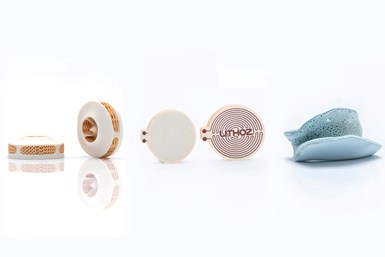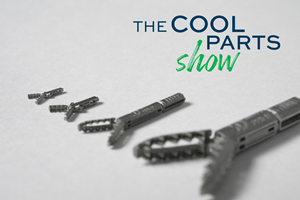Lithoz’s CeraFab Multi 2M30 Creates Multimaterial, Multifunctional Parts
Formnext 2023: The CeraFab Multi 2M30 is a lithography-based ceramic manufacturing 3D printer that can produce highly complex multimaterial structures by combining several materials — not only in varying layers of printed components but also within a single layer.
Display of multimaterial parts (left to right): ceramic and polymer; pure copper and glass ceramic; hydroxy apatite and tricalcium phosphate.Photo Credit: INKplant
Lithoz’s CeraFab Multi 2M30 is a lithography-based ceramic manufacturing (LCM) 3D printer capable of combining different materials — such as ceramic with metal, ceramic with polymer or two different ceramics — in one single functional part and even within one single printed layer. In just one print run, entirely opposing material properties can be flexibly and functionally combined (such as conductive and insulating properties) creating the next generation of multifunctional parts providing previously unachievable detail and complexity.
The printer makes it possible to produce highly complex multimaterial structures by combining several materials not only in varying layers of printed components but also within a single layer. This machine eliminates the need for joining or assembly and makes it easy to replace assemblies with printed parts. It also enables freedom in geometrical design.
Powered by LCM technology, the CeraFab Multi 2M30 can manufacture multifunctional components for various applications, ranging from electronics and embedded sensors to biomedical implants and devices, as well as aerospace, automotive and energy storage systems.
Material combinations, unachievable using conventional technologies, enable two materials between and within layers, advanced composites and more. It is also an open system enabling manufacturers to develop their own materials. Automated cleaning step between material changes, with option to integrate own processes and software further expanding your range of capabilities.
The ready-to-use system consists of two vats, enhancing the speed, accuracy and effectiveness of a clean material switch between and within layers. It also includes a fully automated cleaning step to avoid cross contamination during material changes.
It is powered by CeraFab Control software. The company says special types of advanced composites with varying compositions and/or microstructures — known as functionally graded materials (FGMs) and functionally graded structures (FGSs) — can be produced, as well as complex multimaterial geometries unachievable using any other 3D printing technology. These new possibilities may pave the way for further innovation in industrial, medical and dental applications.
The company’s “ceramic AM factory” enables an array of parts for serial digital production produced by such manufacturers as Bosch Advanced Ceramics, Steinbach and SiNAPTIC, all using the Lithoz LCM CeraFab System printers. Some of these parts include natural-looking lithium disilicate dental restorations and bioresorbable ceramic implants made from hydroxy apatite. Also, multimaterial medical implants unite various bioresorbable materials, demonstrating the capabilities of bioceramics in a future where surgical precision, economic benefit and patient well-being can be brought together.
- Read about the Lithoz partnership with Himed for research on 3D-printable medical-grade bioceramics. This collaboration is designed to help grow the range of biocompatible materials suitable for a future that includes highly customized, patient-specific medical solutions that can be printed on demand.
- Learn about Lithoz’s collaboration with SiNAPTIC for ceramic additive manufacturing. The deal includes joint sales and marketing activities, as well as the purchase of seven Lithoz CeraFab S65 Medical printers for SiNAPTIC’s new research center in Lafayette, Colorado.
- Here are details about the Lithoz partnership with Zenit smart polycrystals’ materials for solid-state lasers. The collaboration includes alignment of Lithoz’s lithography-based Ceramic Manufacturing technology for the Zenit process, as well as support for market, organization and innovation strategies.
Related Content
8 Cool Parts From Formnext 2023: The Cool Parts Show #65
New additive manufacturing technologies on display at Formnext were in many cases producing notable end-use components. Here are some of the coolest parts we found at this year’s show.
Read MoreQ&A With Align EVP: Why the Invisalign Manufacturer Acquired Cubicure, and the Future of Personalized Orthodontics
Align Technology produces nearly 1 million unique aligner parts per day. Its acquisition of technology supplier Cubicure in January supports demand for 3D printed tooling and direct printed orthodontic devices at mass scale.
Read MoreMicro Robot Gripper 3D Printed All at Once, No Assembly Required: The Cool Parts Show #59
Fine control over laser powder bed fusion achieves precise spacing between adjoining moving surfaces. The Cool Parts Show looks at micro 3D printing of metal for moving components made in one piece.
Read MoreActivArmor Casts and Splints Are Shifting to Point-of-Care 3D Printing
ActivArmor offers individualized, 3D printed casts and splints for various diagnoses. The company is in the process of shifting to point-of-care printing and aims to promote positive healing outcomes and improved hygienics with customized support devices.
Read MoreRead Next
Profilometry-Based Indentation Plastometry (PIP) as an Alternative to Standard Tensile Testing
UK-based Plastometrex offers a benchtop testing device utilizing PIP to quickly and easily analyze the yield strength, tensile strength and uniform elongation of samples and even printed parts. The solution is particularly useful for additive manufacturing.
Read MoreBike Manufacturer Uses Additive Manufacturing to Create Lighter, More Complex, Customized Parts
Titanium bike frame manufacturer Hanglun Technology mixes precision casting with 3D printing to create bikes that offer increased speed and reduced turbulence during long-distance rides, offering a smoother, faster and more efficient cycling experience.
Read MorePostprocessing Steps and Costs for Metal 3D Printing
When your metal part is done 3D printing, you just pull it out of the machine and start using it, right? Not exactly.
Read More





















